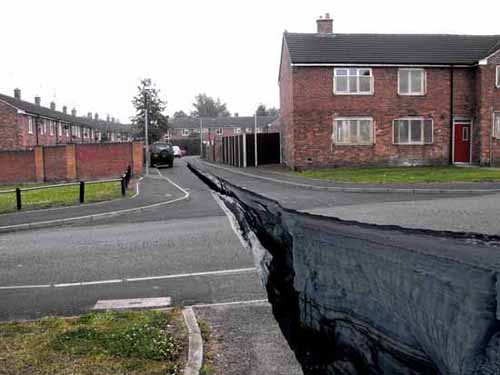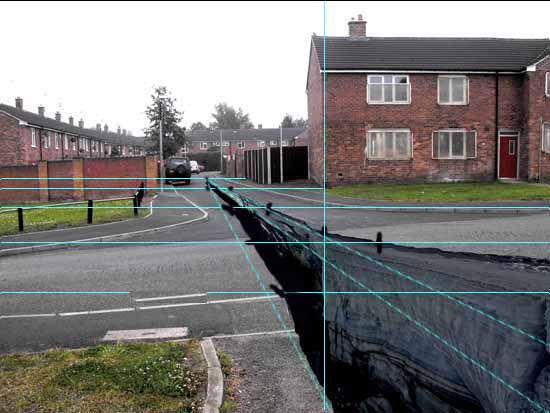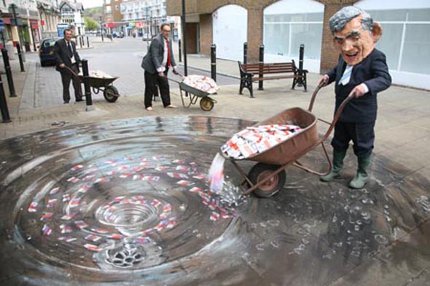Julian Beever 3d paintings are great but I would also like to give mention to, Kurt Wenner, Edgar Müller, who are three other artists, known for doing, modern anamorphic, perspective, 3d paintings, 3d street art and these three artists, give us some proof, that there is more to looking, than just pointing your eyes, in the direction of an object.
Everybody and the dog will tell you, drawing is about looking and do you know what, all of them are right but do you want to know something else, very few of them actually explain what they mean, do they?
How important is it to understand, some basic principles about looking, when trying to understand Julian Beever 3d paintings better?
I don’t know about you but I see so much, I cannot possibly take it all in, we live in a very visually informative world, 80% of all the information we receive, is visual any way. So we are literally, being bombarded with it, saturated with it, we even see things in our sleep or at least, we think we do.
But we actually see very little because it doesn’t register, we are not really looking, we are just seeing, browsing you might say but if you are going to learn to draw, then you need to look, with reason.
Here are some obvious points, that weren’t so obvious, to me once upon a time; I used to lie on the bed, as a kid and draw, but no matter how hard I tried, my pictures never looked right.
When I used to draw at the kitchen table, they always turned out, much better and it was because of the angel I was drawing at, if you try to draw at an angle, lying down, then you will usually end up with, a distorted image. If you only look at this image, from the angle at which it was drawn, it will look more accurate, than if you hold it up squarely in front of your eyes, to view.
This information is very useful, when you look at the fantastic work, created by chalk sidewalk artist’s, Kurt Wenner, Julian Beever and Edgar Müller, these are modern day artist’s, doing chalk, 3d pavement art, that completely turns, this whole problem to an advantage, not only do they make this, a unique selling point but they also, make it their trade mark.
Before Julian Beever, 3d paintings, there was Andrea Pozzo.
There is a name for this type of art, it is called, anamorphic perspective and the earliest examples of this are, by Leonardo Da Vinci and Andrea Pozzo.
Some examples of this early work, can be seen in Andrea Pozzo’s work, on the ceilings of the Jesuit, St Ignatius’ Church, Rome, 1685 – 1694, this masterpiece, is a fabulous example, of illusory perspectives and the dome being of particular importance.
Sant Ignazio ceiling.

Sant Ignazio ceiling further away.

The dome is not real either and from a certain point, marked with a brass plate, on the floor, you find it very difficult, to see that it isn’t.
Kurt Wenner, Julian Beever and Edgar Müller, these guys do this, on the street and also create, fabulous examples of illusory perspectives, so the question for me, is how they do these illusions.
Julian Beever, Edgar Müller and Kurt Wenner.
Julian Beever, 3d paintings.
Kurt Wenner, 3d paintings.
Edgar Müller, 3d paintings.
Edgar Müller uses the computer, to digitally render the work, concepts, ideas, if you can use computer photo editing software, then this is the way to go.
Looking at the way Edgar constructs his drawings, shows that he uses, what looks like masking tape, to get parts of his street paintings accurate, it also looks like he takes an approach, similar to that used in Julian Beever’s, 3d paintings.
Here are just a couple of ideas, I tried, after looking at work done by these other guys but mostly I used Edgar Müller, for inspiration and I was pleasantly surprised.


Julian Beever explains, that he is not a mathematician and has no mathematical skills to speak of; he says that he uses, the good old grid method, in order to construct his drawings. He also uses, a camera on a tripod as a viewer, which enables him to use the fixed position of the camera, to always be able to identify, the exact position, to view the street painting accurately.
A statement made by Kurt Wenner, that explains, how he approaches his work, “Artistic geometry was the most fascinating subject” this could be mathematics, in another name, exactly the opposite to Julian Beever.
If I was going to create the illusion above, then I would do it like this, first of all I would do a scaled painting, on paper of the above image, that would be four times bigger, than the original image, which is A4, so my preparation painting would be A2 in size.
This will give me a greater understanding, of how to construct the drawing and mix the colors, it will give me a feeling for the picture, plus it is a desirable image, in it’s own right. This would also give me two images, to work from and a more informed understanding of what, I would be attempting to create.
I would find the farthest point, from my camera tripod, yes I would use a camera because after carrying out some experiments, I found it to be very helpful for viewing, not just this type of work either, so thanks to Julian Beever.
I also realized that these illusions, don’t have the same impact to the naked eye and after reading extensively, about these artists, I find that they also hint at this.
From the farthest point, I would run a tape like Edgar Müller does, to use this, as an anchor point, for the rest of the picture. Then using identifiable points, in the drawing space, environment, with this actually being the street, I would construct my drawing outline, from reference points identified, when doing the preparation painting.


I would construct my outline by marking in key areas, identifying them from my original image and marking them, with a chalk stick, until I was confident I had enough information, to create my painting. I would keep going back, to the camera to view the image and check for accuracy, I would basically draw it, like any other drawing, by using reference points, from the surrounding landscape, to identify reference points in the drawing/painting. This is a necessary, continual and ongoing process, when doing any kind of drawing but even more so, when doing anamorphic perspectives, you need to be checking and double checking for accuracy, just like Julian Beever and others, my favorites are the Julian Beever, 3d paintings.
If you would like to find out more, about how to do this, then follow this link, to Julian Beever sidewalk art, chalk art and see some more of his work, and get a better understanding of Julian Beever, 3d paintings.
Julian Beever pavement art, sidewalk art, chalk artist, has new work that can be observed in his book (Pavement Chalk Artist) 2010, it’s a lovely full color book, showing some wonderful new images and insights about how, exactly, he found his path, to creating, this popular form of street art. I loved reading through this book and attaining a glimpse, into the artist himself, I purchased mine from Amazon . com, it was worth it, much better than any e-book, I could down load off line and sits nicely on the shelf, in my collection, begging visitors, to also take a look.
Click below to obtain a price on Amazon . com.


